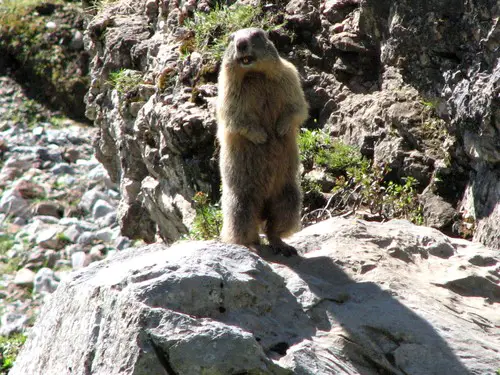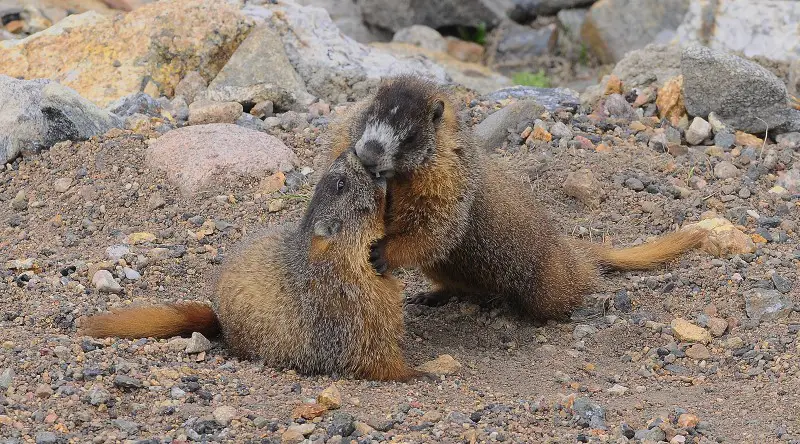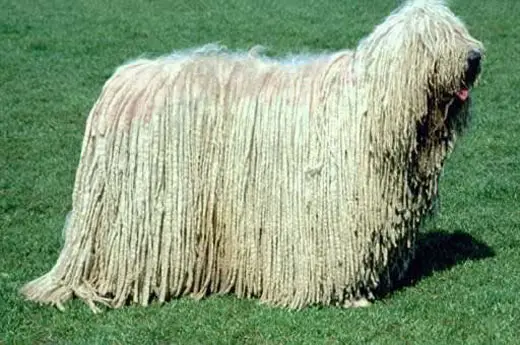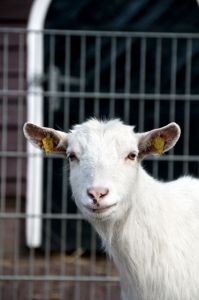Alpine Marmot
The Alpine Marmot is a muscular rodent of the squirrel family, who spends most of its life underground. These small creatures can dig a cave earth so solid, that a human with a pickaxe would have trouble doing the same. These small mammals inhabit territories mostly in the central and western part of the Alps, while there are also smaller populations in territories more to the east.
An adult Alpine Marmot reaches the size of 50-60 cm, weighing as much as 8 kilograms before the winter hibernation. They have a typical rodent appearance – medium-length, coarse coat, coloured grayish brown to almost red, with a fluffy, dark tail and grayish black head. It should be noted, that they don’t posses the extremely strong teeth that other similar species do.
Alpine Marmots dig their cave labyrinths on mountain sides quite high above sea level. Each tunnel system is inhabited by a Marmot family, and the incredible complexity of these shelters makes it likely that they are a result of multiple generations’ work. Each of these tunnel systems have multiple entrances (a cave with 76 entrances was once found), and inside there multiple “rooms” – a storage area, a toilet, a sleeping area. All the tunnels are furnitured with dry grass and plants. It is no wonder that these creatures don’t allow other specimen in their territory, marking it with scent and even fighting for it, if necessary.
These rodents feed in the morning and afternoon. They don’t like heat, and in hot summer days they sometimes don’t eat at all. One Marmot stays alert for predators, while other members of the family feed. As their teeth are not as strong as other rodents’, they feed only on the softest vegetation – leaves, fresh grass and flowers. The Alpine Marmot has to consume a lot of food to store fat, later to be used during the winter hibernation.
When the summer is coming to an end, the seniors of the family try to collect as much dry grass and plants as possible, furnituring the caves with it. After this is done, the family enters the cave and seals it off for the winter – this usually happens in October. All the Marmots squeeze together tightly in a special “bedroom” and enter hibernation. During the winter, up to 50% of the body mass is lost, using it for energy while sleeping.
In early spring, right after waking up from the winter sleep, the Alpine Marmots start mating. The reason for this behaviour is simple – the sooner the young are born, the higher are their chances to store enough fat to be able to survive through the winter. After a seven week long pregnancy, 1-7 pups are born. They leave the cave for the first time only about 40 days after birth and reach sexual maturity only when they’re two years old. Life expectancy of these small rodents is 15-18 years in captivity, less in the wild.
Currently, Alpine Marmots are not endangered, although they are affected by the destruction of mountain environment. In the past, these animals were hunted because it was thought that their fat cures rheumatism.





What do Marmots Drink? This is for a school project and I can’t find it any freaking where.
i have no idea.